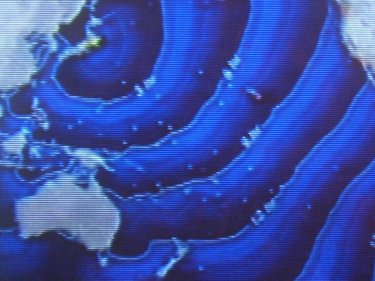AUTHORITIES in Bangkok and on Phuket will be watching the shocking tsunami quake aftermath unfold in Japan today.
The message that the shockwave sends to every country in the quake zones of the Pacific and Indian Oceans is: be prepared.
Eternal vigilance is the only way of coping with the prospect of the devastation that a large tsunami can wreak.
On December 26, 2004, the Indian Ocean tsunami devastated the Andaman coast. Phuket became forever connected with the tsunami, even though other parts of the region were hit much harder by it.
Now it's Japan's turn, and with other nations also possibly going to be struck as the waves spread. Like the Indian Ocean tsunami, today's quake came in daylight.
The concern that needs to be borne in mind by tsunami-watch officials in Phuket and Bangkok is that a tsunami could just as easily strike at night, when everyone is asleep.
While the warning system has improved over the years, there is still a disconnect between the authorities and the resorts and other places where tourists stay.
If you are in a resort within the Andaman coastal zone, ask the management: ''Who will wake me if a tsunami strikes between 1am and 6am?''
A second tsunami in the region is considered unlikely, but today's Japan tsunami indicates that everybody has to be fully prepared, just in case.
About 340 people died on Phuket in 2004. Further north in Khao Lak, although the population then was one tenth the size of Phuket, 10 times that number of victims were killed.
About 5400 people died in Thailand from the 2004 tsunami, half Thais and half expats. Around the region, about 220,000 people were killed, with 160,000 in the Indonesian province of Aceh alone.
Thailand was exceptional because international teams of forensic experts gathered on Phuket and managed to identify all except 380 victims out of the 5400 over the next two years.
This message was posted as a comment overnight by a reader who runs a resort:
Whilst this tragedy unfolds in Japan and (potentially) in the Pacific Islands, now is a good time to ask exactly what the step-by-step process for identifying a possible tsunami in the Andaman Sea, and the procedure for notifying the many resorts and local populations along the Andaman Coast.
I assume that an undersea earthquake would be initially registered by both the US (and other nations) earthquake monitoring sensors, as well as thailand's warning buoys.
What then? That data is presumably relayed to relevant government authorities, and a decision made whether or not to alert the local population.
How is that tsunami alert made? I assume that tsumani warning towers in the area of danger would be activated, (unless the copper power cabling has been stolen).
Does the government have a process to issue alerts via local TV and radio?
How about alerts issued via the various cable TV tourist channels?
What about SMS alerts? Is there a service that we can subscribe to?
Is an automated telephone call made to resorts and hotels in the area?
You can gather than I'm totally in the dark about what procedures should be followed, and what warning alerts would be provided.
The worst part of all this 'confusion' is that I own a hotel which lies only a few hundred meters from the Andaman Sea. In the 6+ years since the 2004 tsunami, I have never received any printed or verbal advice from any government authority, nor been invited to attend any meeting where hotels like mine are instructed about what to do in the event of a tsunami warning.
Guess we just have to use our own common sense then...
Simon Lutrell
The Tsunami: Week One Recalled
What was it like in that first week after the tsunami? Here one Phuket resident relates the story as it was reported in other places. This article has never appeared in print on Phuket.
The Tsunami: Week One Recalled
Bodywork: How Tsunami Victims Reclaimed Names
The work by international police created the greatest forensic detective saga in history. Here is a report from the first 100 days.
Bodywork: How Tsunami Victims Reclaimed Names
Water and Fire: A Tsunami Reunion
The poorest unidentified victims of the tsunami in Thailand are the ones who still have yet to be reunited with relatives. Here from 2007 is a report of one such reunion.
Water and Fire: A Tsunami Reunion
The Man Who Waits in the Cool Container
Lost and found. Those three words tell a tsunami story that applied to thousands of victims. But for one of the lost and found, there has been no reunion with loved ones. And there may never be.
The Man Who Waits in the Cool Container
Thai Official Accused of Tsunami Corruption
Accusations of corruption by a Thai official take the edge off a generous international tsunami project that involved about 40 countries and gave names back to thousands of unidentified victims.
Thai Official Accused of Tsunami Corruption
Tsunami Warning Test: How Safe Are We?
Warning drills for a tsunami are easy in sunshine. But the unpredictable arrival of a big wave in the middle of the night, when telephones and television are switched off, leaves us asking: How safe are we?
Tsunami Warning Test: How Safe Are We?
Tsunami ID Cremation Mix-ups Trouble Families
The return of the wrong bodies to families of some tsunami victims is believed to be making the highly praised Thai Tsunami Victim Identification process even more complicated. PHOTO ALBUM
Tsunami ID Cremation Mix-ups Trouble Families










(moderated)
Posted by Zig on March 11, 2011 18:07
Editor Comment:
No interest in fortune tellers and predictions of tsunamis, zig. Don't waste your time and mine.